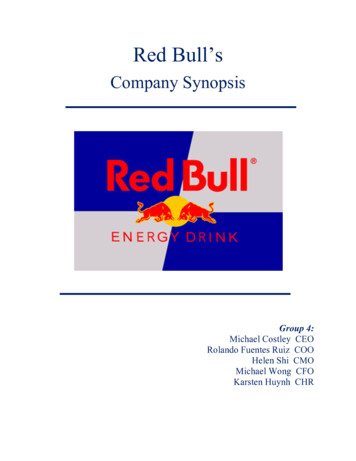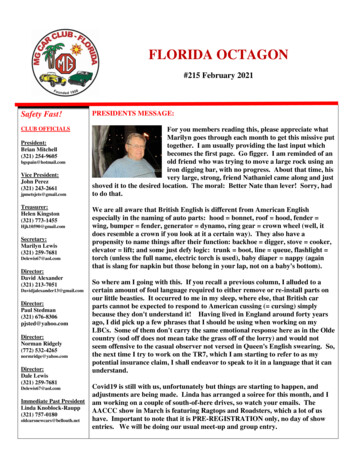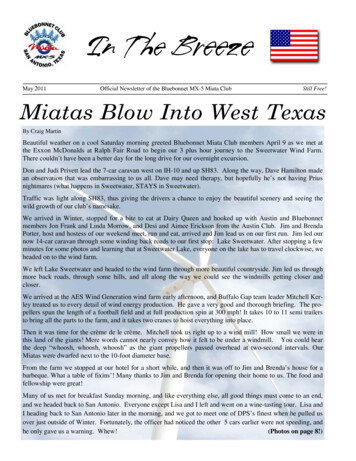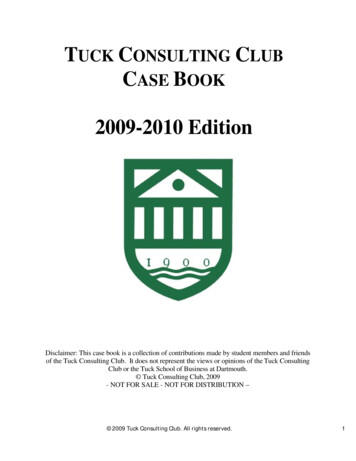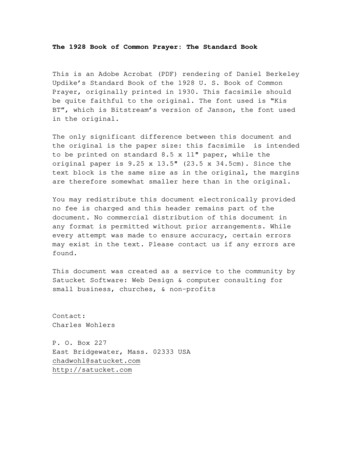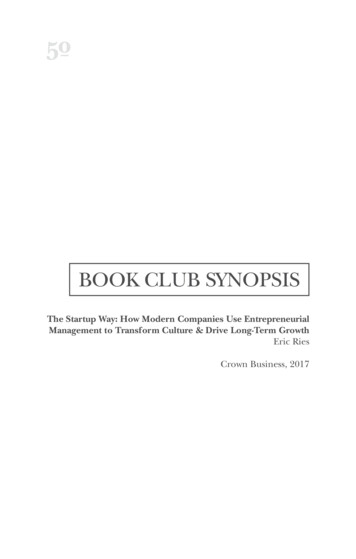
Transcription
BOOK CLUB SYNOPSISThe Startup Way: How Modern Companies Use EntrepreneurialManagement to Transform Culture & Drive Long-Term GrowthEric RiesCrown Business, 2017
CONTENTSIntroduction 3Part One: The Modern Company 7Chapter One: Respect the Past, Invent the Future 9Chapter Two: Entrepreneurship: The Missing Function 14Chapter Three: A Startup State of Mind 18Chapter Four: Lessons From The Lean Startup 23Chapter Five: A Management System for Innovation at Scale 29Part Two: A Road Map for Transformation 32Chapter Six: The Transformation: Phase One 34Chapter Seven: The Transformation: Phase Two 40Chapter Eight: The Transformation: Phase Three 45Chapter Nine: Innovation Accounting 47Part Three: The Big Picture 53Chapter Ten: A Unified Theory of Entrepreneurship 55Chapter Eleven: Toward a Pro-Entrepreneurship Public Policy 58Epilogue: A New Civic Religion 61About 63
introIn the first pages of The Startup Way, Eric Ries references his previousbook, The Lean Startup, published in 2011. The conclusions of that bookwill be discussed in greater detail at the end of Chapter 4, but in short,The Lean Startup provided a scientific approach to managing startupsand getting products to customers faster.The Lean Startup granted Ries access to all manner of organizations,including large firms, where he engaged in conversations with thoughtleaders. Fueled by these discussions, Ries wrote The Startup Way to buildon the lessons of The Lean Startup and chiefly, to lay out a framework forentrepreneurial management leaders to drive sustained growth inuncertain environments.BUILDING THE MISSING CAPABILITIESRies opens the book with an anecdote about a trip to General Electricupon the invitation of the company’s top management, which ultimatelyresulted in his helping create GE’s FastWorks process built on leanmethods. They discussed the company’s new Series X diesel and naturalgas engine, and they realized they “could get to market radically fasterby building a simpler engine in a matter of months, not years.” Thefollowing day, Ries met with the founder of a hypergrowth tech startupto talk about how the company could scale beyond its first successfulinnovation.3
While on the surface the conversations may seem different, Ries realizedthe issues facing both behemoth GE and the emerging startup were“surprisingly similar”: They both needed entrepreneurial cultures, andthey were lacking some of the same capabilities. In fact, he concludedthat today’s organizations—whether established or emerging—areoften missing particular three capabilities that are critical to long-termsuccess: “the ability to experiment rapidly with new products and newbusiness models, the ability to empower their most creative people, andthe ability to engage again and again in an innovation process—andmanage it with rigor and accountability—so that they can unlock newsources of growth and productivity.”Ries explains he initially thought corporate staffers were different fromcreative entrepreneurs like himself—and that “once organizations reacha certain size, they start dying slowly, from the inside.” But eventually aparadox emerged that caused Ries to change his mind: Ultimately, anyhigh-growth entrepreneur is trying to build a big company; they simplythink their company will remain scrappy and nimble—which is rarelythe case. So Ries worked with thousands of managers and founders,from organizations like GE and Toyota to startups like Dropbox andAirbnb, to refine his approach detailed in the book.THE FIVE PRINCIPLES BEHIND THE STARTUP WAY:1.Continuous innovation: Great leaders seek out newbreakthroughs repeatedly and draw from creativity at every level.2.Startup as atomic unit of work: Companies need teams that canexperiment to unlock new sources of growth.3.The missing function: Entrepreneurship is just as vital to futuresuccess as marketing or finance, yet most companies are missing it.4.The second founding: Find a way to make a profound change,whether the company is five or 100 years old.5.Continuous transformation: Companies must figure out how tocontinually rewrite their organization’s DNA.4
THE BOOKPart one of The Startup Way will “uncover why traditional managementpractices are no longer up to the task” and why this moment in history isso critical. Part two will “dive into the ‘how’ of the Startup Way,” andpart three will “explore what happens once the transformation processis ‘complete.’”5
part oneTHE MODERN COMPANYPart one opens with a short anecdote about short-term lodgingsstartup Airbnb, which uncovered a hidden market and grew to a 30billion valuation in just 10 years. But the company realized it had tocontinue evolving beyond its current success, and it created a teamthat ultimately launched a product called Airbnb Trips—which willbe discussed in greater detail in Chapter 8. This part of the book willexplore “what it means to become a modern company, and theentrepreneurial structure it needs to survive and embody a long-termvision for the future.”7
01CHAPTER ONERESPECT THE PAST, INVENT THEFUTURE: CREATING THE MODERNCOMPANYIn a discussion with GE CEO Jeff Immelt, Ries posited a theory: Amodern company “harnesses the creativity and talent of every singleone of its employees.” Most business leaders recognize, however, thatrunning the core business leaves little time to test new ideas. They areanxious about the unpredictability of the world, including factors likeglobalization, automation, the explosion of startups in nearly everyindustry and the speed of change in both technological advances andconsumer preferences.Beyond those external forces, today’s managers are increasinglypressured to launch new products and enter new markets—and thuscreate even more uncertainty themselves. Meanwhile, the state ofglobal communications means that new products can come fromanywhere, and the capital costs required to try something new aredrastically reduced because the entire supply chain can be borrowedfor little investment.THE MANAGEMENT PORTFOLIOThese factors are shifting the nature of competition, and to survive,many companies must create “new sources of growth that can onlycome from innovation.” This has real effects on the managementportfolio of a company, as traditional management tools often don’twork in areas where innovations are being attempted. “Yet mostcompanies don’t have anything to replace them with—yet.”9
WHY TRADITIONAL MANAGEMENT TOOLS STRUGGLEWITH UNCERTAINTYTraditional management tools struggle with uncertainty. Decades ago,General Motors’ Alfred Sloan pioneered a structure of producingestimates for performance in an “‘ideal’” year, working to reducemiscalculations and waste. That system “became the basis for all oftwentieth-century general management. . It is one of the truerevolutionary ideas of the past one hundred years.” But this forecastingwas designed in a different time and context, and it is still being usedin situations where it doesn’t work. In some cases, “failure to hit theforecast means a team executed poorly. But sometimes it means theforecast itself was a fantasy.”HOW DO WE DEAL WITH FAILURE?Ries recognized that tension when he met one day with the GE’s SixSigma leader for industrial business. Six Sigma—one of the mostfamous corporate transformations spawned by Sloan’s work—is aprocess to develop and deliver near-perfect products, designed with nomore than 3.4 defects per million opportunities.While in the Six Sigma leader’s office, Ries noticed the mug on theleader’s desk read: “[Failure is not an option.]” Since Ries had seenmany situations where “reality proved too unpredictable to avoidfailure,” he knew that startups would find that statement ridiculous.Sensing this, he decided to dream up his own slogan, and eventuallylanded on one that he felt would reflect the thoughts of the world’smost successful entrepreneurs: “‘I eat failure for breakfast.’”The difference between these slogans not only reflects why startupshave found it difficult to adopt traditional management methods andvice versa, but it also demonstrates a discrepancy. Baked into methodslike Six Sigma is the idea that careful planning and execution canprevent failure—but the startup part of the management portfoliochallenges that presupposition.10
CHANGING HOW COMPANIES “GROW UP”Ries quotes Dropbox CTO Aditya Agarwal, who summed up “theentrepreneurial dilemma”: “One of the reasons it’s hard to build newthings at larger companies is because people don’t have the mentalmodel of ‘My job is to actually learn new things.’” Instead, the mentalmodel is about getting good at something and continuing to do that,albeit with incremental learning about perfecting the craft. That’s why,said Agarwal, “[even] companies that seem to have launched one goodproduct won’t easily know how to do it again.”Even the innovative Dropbox has run into many of the same problemsthat plague traditional companies. After launching two new flagshipproducts, Mailbox and Carousel, the startup was disappointed in theirscale and ultimately shut them down. Agarwal has said of the reasonsfor this kind of failure, “‘We did not get enough pertinent userfeedback. We were building and building but not listening enough.’”He added, “‘It was the most painful experience the company has gonethrough but also the most rewarding and important one.’” Dropboxtook those painful lessons and adopted a series of changes beforelaunching Paper, a new collaboration tool, in January 2017.PROFITING FROM FAILURE AT AMAZONAt Amazon, it was the Fire phone that proved a flop. “Over the courseof four years, the project went from an idea detailed in an aspirationalmocked-up press release to almost universal disappointment after itslaunch in the summer of 2014. Initially priced at 199, the Fire sooncost only 0.99, and by the following winter, the company took a 170million write down based mostly on unsold phones.”Undaunted, Jeff Bezos saw it not as a time for layoffs, but as anopportunity to learn. Ries quotes Bezos: “What matters is thatcompanies that don’t continue to experiment or embrace failureeventually get in the position where the only thing they can do is makea Hail Mary bet at the end of their corporate existence.” The Fire teammoved to other projects, and Amazon at large was getting into newmarkets from food delivery to original television. Ries posits that thisoffers a lesson: “Even in situations where you can’t forecast, you can11
still plan.” The Fire’s launch didn’t go as expected, clearly, but thereexisted an assumption of risk that allowed the company to succeed inthe long term anyway.A FOCUS ON LEGACYMost business leaders inherit their organization from a priorgeneration. So they must ask themselves: How can I leave the nextgeneration with a stronger business, and what do we want our legacyto be?Facebook COO Sheryl Sandberg tells a story about a meeting in whichan employee complained about the “‘unfairness’” of their performanceevaluations being based on overall project success, rather than theirindividual contributions. Her response has stuck with Ries for years:She asked the staffers to imagine a disrupted company like Kodak orBlackBerry-maker RIM. By doing so, she prompted everyone in theroom to think about all of the positive reviews, promotions and bonusesemployees at those companies received for their individualcontributions in the years leading up to the organization’s defeat.Finally, she asked, “Do you really want to be one of those managers?”THE MISSING SYSTEMRies also visited Toyota, where he met with Shigeki Tomoyama, thechief officer of the IT and ITS groups, to discuss the process describedin The Lean Startup. There, Tomoyama-san explained Toyota’slegendary high-quality production was missing “‘a correspondingsystem for discovering what to produce in the first place.’” Thecompany’s production was highly efficient, but it had lost some of itsinnovative spirit.A TRULY MODERN COMPANYIn the final pages of the chapter, Ries provides several specific examplesof old-fashioned versus modern companies. “A modern company isone in which every employee has the opportunity to be an entrepreneur.It respects its employees and their ideas at a fundamental level,” hesays. “A modern company is disciplined at the rigorous execution of12
their core business—without this, no innovation is possible—but italso employs a complementary set of entrepreneurial managementtools for dealing with situations of extreme uncertainty.”For example, an old-fashioned company is siloed, while a modern onecomprises cross-functional teams. Old-fashioned organizationsoperate huge programs, while modern ones operate rapid experiments,and old-fashioned companies are comprised of managers andsubordinates, while modern companies consist of leaders and theentrepreneurs they empower.13
02CHAPTER TWOENTREPRENEURSHIP: THE MISSINGFUNCTIONBefore marketing was a formal function, it was the responsibility ofeveryone—and no one—to get the word out. Of course, now we seethat memorable marketing demands excellence and someone incharge, just like other functions, such as IT and finance.In today’s “typical organizational structure, who’s in charge ofgrappling with uncertainty, unlocking unexpected and dramatic newforms of growth and impact, translating research insights into viableproducts, and harnessing the forces of disruption in the organization?”At small startups, it’s usually the founders. But once a company grows,at a certain point, the honest answer is usually “nobody.”“The lack of a system for acting on new ideas is a huge problem forexisting corporations that have had decades—sometimes longer—tobecome encumbered by layers of bureaucracy or hampered byburdensome ‘this is how we’ve always done it’ practices.” And it oftenbecomes a problem at hypergrowth startups after an expansion, too.THE ENTREPRENEURIAL FUNCTIONWhen Ries meets with CEOs, he often asks who is responsible for thefollowing two fundamental tasks:1.Overseeing high-potential growth initiatives that could one daybecome new divisions of the company.”2.“Infusing everyday work across the organization with anentrepreneurial, experimental, iterative mindset.”14
These responsibilities rarely show up on an organizational chart.Instead, they fall to a low spot on the priority list for existing functionalmanagers with many other day-to-day responsibilities—or even worse,they are considered “‘everyone’s responsibility.’”Ries declares “it’s time to move beyond these half-hearted measuresand see entrepreneurship as a core discipline of a modern company. Ithas the singular role of being the overseer of the organization’s ‘startupDNA’—infusing an entrepreneurial mindset and techniques into thewhole organization in order to invest in the next generation ofinnovations on a continuous basis.”Great entrepreneurs can and should come from anywhere, and moderncompanies don’t need just another innovation lab. Rather, “[they]need the ability to consistently and reliably make bets on high-risk,high-reward projects without having to bet the whole company. Andthey need to find, train, and retain the kind of leaders who can pullthis off.” Ries believes this practice should simply be called “functionentrepreneurship.”STARTUP AS ATOMIC UNIT OF WORK“The first responsibility of the entrepreneurship function is to overseethe company’s internal startups. The company’s leaders need to understandthe startup as an atomic unit of work, distinct from other kinds of projectteams that companies typically employ.” While a startup is not the bestmanagement form for everything, it is the best form for performingwell amid extreme uncertainty.INTEGRATE STARTUPS INTO THE PARENT ORGANIZATION“The second responsibility of the entrepreneurial function is to managethe problem of success.” A startup that is succeeding is more dangerous tothe organization than one that fails, because it threatens the establishedorder. So “the question is: For any experiment that succeeds, how willit find a home in the organization? Will it be absorbed by an existingdivision to become an entirely new division? How is that decided?Whose decision is it?” Ries notes these topics will be covered in detailin part two of the book.15
IDEAS ARE VALIDATED, ADOPTED, AND SCALED“Every division needs a way to test, refine and scale new ideas in orderto innovate and grow. But ideas by themselves are worthless.”Discovering the potential of new ideas requires the presence of adedicated yet flexible team that can pivot when needed. It’s conventionalwisdom in the startup world that entrepreneurial management isdistinct from general management, but it’s important to note thesecannot be kept in isolation from each other. Instead, they mustoperate together.Further, startups must execute in the context of the company. “Thescarcity of resources most startups deal with argues for more, not less,financial discipline. Thus, every organizational unit is more properlyunderstood as a portfolio that contains some mix of discovery andexecution.”ENTREPRENEURSHIP IS NOT JUST FOR ENTREPRENEURSEntrepreneurship is not only for products, nor is it just for entrepreneurs.The entrepreneurial function impacts and supports other functions indoing work more effectively. “Ultimately, the non-entrepreneurs arejust as important customers of the entrepreneurial function as theentrepreneurs themselves for three reasons:”1.Lean Startup-style tools can be quite helpful in situations thathave some degree of uncertainty, even if it isn’t extreme.2.Non-startup managers need to know what’s going on, becauseentrepreneurs inevitably create conflict that will climb up thechain of command.3.Entrepreneurs can and should come from anywhere in theorganization—and you never know who they are going to be.Chapter 10 will discuss in greater detail ideas about who can andshould be an entrepreneur, but Ries first discusses the problem ofwhere to find them.THE UNDERGROUND NETWORK“Every company has people who are willing to take risks to serve thecustomer better without regard for their own popularity.” One such16
example is the type of people who worked on GE’s Series X enginementioned in the introduction of the book. GE’s Vice Chair BethComstock said she had always known such people were at the company,but she had no formal way to help them thrive prior to the developmentof the FastWorks process: “‘I think there are always people in theorganization who get it intuitively,’ she says. ‘They’re just waiting to beunleashed. You don’t know where they are, but once you give them theopportunity and the tools to focus them, they are just on fire.’”With one product manager on the Series X team in particular,Comstock noticed that whenever a good idea bubbled up through aparticular brainstorming program, this employee had something to dowith it. These types of people exist at every company, Ries explains.“On the outside, they look like everyone else, moving along thepromotion chain and doing their jobs well. But they’re also part of akind of underground network that can be tapped for unusual projectsfrom time to time.”THE MISSING ORGANIZATIONAL CAPABILITIESTo support high performers and their way of working, Ries suggeststhat organizations ask and answer the following questions:1.How do we create space for experiments with appropriate liabilityconstraints?2.How do we fund projects without knowing the return oninvestment in advance?3.How do we create appropriate milestones for teams that areoperating autonomously?4.How do we provide professional development to help people getbetter at entrepreneurship as a skill?5.How can we provide networking in and out of the company, sopeople will understand their new identity as a corporateentrepreneur?6.How do we put the right people on the right teams?7.How do we create new incentive and advancement systems?To answer these questions, Ries turns to the structures of Silicon Valley.17
03CHAPTER THREEA STARTUP STATE OF MINDStartup people disagree on many things, but everyone “universallyadheres to a series of deeply held convictions. These convictions formthe true foundation of the structures that allow Silicon Valley startupsto achieve their unique blend of risk-taking and rapid growth.” Riesexplains that this chapter is not meant to be an exhaustive explanationof the way Silicon Valley works but rather a discussion of “the distinctivemanagement structures the startup movement has pioneered that—though rarely explicitly acknowledged—are key to its success.”“IT’S ALL ABOUT THE TEAM”“The most commonly held belief in Silicon Valley is that ‘it’s all aboutthe team.’” While corporate managers seek good ideas for what is to bedone and then try to find the right people to carry them out, SiliconValley investors make decisions by looking at people first, and then theidea. The marker of future success is the ability to formulate a goodplan—and not necessarily a specific idea or strategy, which can changealong the way. Conviction is the most prized attribute investors seek.SMALL TEAMS BEAT BIG TEAMSIn traditional corporate structures, the size of the team is indicative ofthe project’s importance; in the startup world, in contrast, the belief isthat “small teams can grow into big teams and have a disproportionateimpact.” At Google, for example, if it’s “‘possible for ten to fifteenpeople to contain all of the knowledge necessary to debug Google Web18
Search, then that’s how many [people] there are.’” A small teamengenders an intense bond and makes for an extremely adaptablegroup. The physical and emotional closeness creates accountability,and it also makes startup teams well-suited to pivot, if needed.EVERY TEAM HAS A CROSS-FUNCTIONAL STRUCTURE ATITS CORE“Startups are inherently cross-functional. Even if they begin with, say,a team of all engineers working on a hot new product, they inevitablyface problems beyond engineering: financing, customer acquisition,marketing, customer service.” Usually, the founders and the early teamhave to solve these cross-functional challenges on their own—unlessthe company has found enough success and funding to bring infunctional experts.EVERY PROJECT STARTS WITH THE CUSTOMER IN MINDRies has worked with many teams in traditional corporations that don’tfully understand the problem they are trying to solve from theircustomer’s point of view. While a company might point to insufficientmarket share as a concern, Ries observes that few customers wouldshare that belief: “Customers don’t care about our market share; theyonly care if we make their lives better.” To avoid falling into this trap,Amazon uses a method called “‘working backward.’” Before makingany new product, the company creates a short internal press releasedetailing the problem, the existing solutions and why the new productwill solve that particular issue better than anything else has.SILICON VALLEY STARTUPS HAVE A SPECIFIC FINANCIALSTRUCTUREIn Silicon Valley, it makes sense that every employee has a stake in theoutcome of the company, so employees are typically offered equityownership as part of their compensation. This ties employees’ financialincentives to the organization’s long-term health, and it “allowsemployees’ intrinsic creativity and commitment and motivation toflourish.”19
WE ARE METRICS-OBSESSEDNo one truly knows what the future cash flow of a company will be, butit’s still possible to measure value. “Every modern startup possesses ametrics dashboard that the team and board revisit on a regular cadence(schedule). The even more recent trend is to post real-time versions ofthis dashboard up around the office, on large flat-screen monitors thatare visible to everyone. This is part of the transparency that startupstend to favor and that many large enterprises find frightening,” but ithelps to ensure that “everyone shares the same set of facts.”METERED FUNDING STAGES RISKRies once took a team of large-company executives on a Silicon Valleytour, and the group visited a startup in which Ries had invested. Theexecutives were “aghast” when they found out Ries and other investorsweren’t demanding accountability measures like progress reports. Incontrast, the startup founder was “baffled” they thought such thingswould happen. Ries explained to the executives that risk mitigation inSilicon Valley uses metered funding, meaning that after a round of seedstage fundraising, the money is transferred into the startup’s bankaccount. “In Silicon Valley, the money is yours. You can spend it onwhat you like with minimal oversight (especially in the early stages).But Lord help you if you try to raise more money and you haven’t madeany progress,” Ries notes. It provides a balance between mitigating riskand allowing the freedom to innovate.BOARD/INVESTOR DYNAMICS ARE KEYStartups report to a board of directors not on a set schedule but whenthe founders think a meeting is appropriate. Rather than on artificialtimelines, these reviews are based on actual progress. “Boards aredesigned to help the company think through strategic issues andwhether or not to pivot. The process works because it’s linked to meteredfunding.” The board is also a streamlined way to update the manygroups and people who have an economic interest in the startup, asventure firms are typically investing not their own money but that oflimited partners, such as wealthy individuals or pension funds. Incontrast to a traditional corporate structure—in which teams aresubjected to a barrage of meetings, such as formal reviews, budget20
updates and constant middle-manager check-ins—the startup methodflows information in a way that doesn’t hinder employees’ ability toproduce results.OUR CULTURE IS EXPERIMENTAL AND ITERATIVEBy implementing all of these structures, “startups create anorganization in which people can try things out without causingfinancial ruin. This is key to inspiring a culture of trust. When acompany is set up properly, there’s no incentive to cover up failure; thewhole idea is to search for truth, not a false message of profitprojections.” While this system has loopholes, such as the potential forfraud, it is excellent for allowing experimentation.WE BELIEVE IN MERITOCRACY“This is one of the most universally held beliefs in the startupmovement: that good ideas can come from anywhere and that peopleshould be given resources and attention based on their talents, nottheir pedigree.” Ries acknowledges this idea of meritocracy is bound incontroversy, however, since many deserving groups are not treatedfairly in the funding and hiring processes. Still, Silicon Valley cannotproperly be understood without mention of the meritocracy concept,“because everyone who lives and works there wants it to be true.”A STARTUP IS MISSION—AND VISION—DRIVEN“Silicon Valley is obsessed with vision and the ‘visionary founder’who can uniquely execute it.” Nothing can truly replace vision.Without it, a startup cannot pivot because “[a] pivot is a change instrategy without a change in vision. . The vision is the part of the team’smission that is nonnegotiable.” As Jeff Lawson, the CEO of cloudstartup Twilio, says, “‘You’re not going to get anywhere if you have abig vision but you’re not solving the customer’s problem. If you’re notsolving a problem, you’re never going to be given the ability toimplement that grand vision.’”21
WE BELIEVE IN ENTREPRENEURSHIP AS A CAREER PATHSilicon Valley values the “‘founder mentality’” that entrepreneurialemployees gain an through their work in startups, as early staffers ofsuccessful startups often gain more responsibility as a much faster ratethan is typical in other types of organizations. The ability to work andlead in this environment is a particular skill that is “absolutely distinctfrom most other business skills that lead to success in a corporateenvironment.”Ries cautions that the practices outlined in this chapter are not meantto suggest that Silicon Valley is infallible, or that adopting them willlead to automatic success in innovation. Rather, it is meant to providethe basis of a language for talking about these practices as they informthe management system discussed throughout the book.22
04CHAPTER FOURLESSONS FROM THE LEAN STARTUPBecause The Startup Way is built on the lessons in Ries’ previous book,he devotes this chapter to summarizing the basic principles in The LeanStartup. First, he lists the Lean Startup method’s five basic steps:“Identify the beliefs about your project that must be true in order for itto succeed. We call these leap-of-faith assumptions.”“Create an experiment to test those assumptions as quickly andinexpensively as possible. We call this initial effort a minimum viableproduct.”“Think like a scientist. Treat each experiment as an opportunity tolearn what’s working and what’s not. We call this ‘unit of progress’ forstartups validated learning.”“Take what you’ve learned from each experiment and start the loopover again. This cycle of iteration is called the build-measure-learnfeedback loop.”“On a regular schedule (cadence), make a decision about whether tomake a change in strategy (pivot) or stay the course (persevere).”As discussed in the last chapter, startups are about vision. The goalof the Lean Startup method is to find the fastest path to realizingthis vision.23
LEAN STARTUP AT THE DEPARTMENT OF EDUCATIONBefore delving into each of the five steps, Ries presents a Lean Startupexample at a surprising organization: the U.S. Department ofEducation. In August 2013, U.S. President Barack Obama announcedhe was seeking a better way to hold higher education institutionsaccountable for serving their students and providing value.Lisa Gelobter, the Department of Education’s chief digital officer,explained that everyone had different ideas about how to approach theproject and which metrics to focus on, including graduation rate,sticker price, financial aid and more. She said, “We took a step backand
3 In the first pages of The Startup Way, Eric Ries references his previous book, The Lean Startup, published in 2011.The conclusions of that book will be discussed in greater detail at the end of Chapter 4, but in short, The Lean Startup provided a scientific approach to ma
